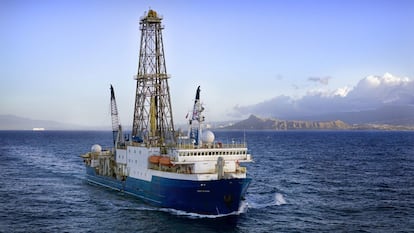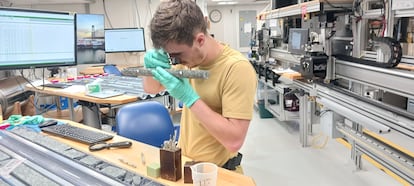Longest rock core from Earth’s mantle opens window into the origins of life
A historic survey of the Atlantic Ocean floor sheds light on the chemical reactions between minerals and seawater that may have given rise to living beings

The scene was like something out of a 19th-century adventure book. French geologist Rémi Coltat recalls setting out from the Spanish city of Granada, where he worked at the Andalusian Institute of Earth Sciences, to embark on an epic journey into the Earth’s mantle. The U.S. ship JOIDES Resolution set sail from Ponta Delgada, in the Portuguese archipelago of the Azores, on April 12, 2023. It stopped in the middle of the North Atlantic and began drilling into the ocean floor, just 800 meters from the Lost City, a strange underwater territory where hydrothermal vents have raised ghostly towers. Coltat recalls the “screams of joy” when, in the ship’s machinery, rocks from the Earth’s mantle began to appear: a column of 1,268 meters, the largest sample ever obtained. Coltat says the discovery is “a window into the development of life” on Earth.
Dutch geologist Johan Lissenberg led the scientific team. “One hypothesis for the origin of life is that it depended on reactions between seawater and rocks like the ones we have recovered,” explains Lissenberg, from Cardiff University in the United Kingdom. These reactions transform the mineral olivine — predominant in the upper layer of the Earth’s mantle — into serpentine rocks, in a process called serpentinization. “This releases hydrogen and subsequently compounds such as methane, which create the conditions in which microbial life can thrive,” says Lissenberg. His expedition was the 399th of the International Ocean Drilling Project Expedition, a 21-country initiative launched a decade ago.
The Lost City is located in the Atlantis massif, an underwater mountain slightly higher than Mount Teide in Tenerife. The conditions there are extreme: temperatures of over 90ºC and very alkaline waters, with carbonate towers reaching 60 meters. The Earth’s mantle is at a depth that cannot be accessed with current techniques: normally more than six miles below the Earth’s crust. But in the Atlantis massif, it is within reach thanks to the separation of two tectonic plates. “These are rocks from the mantle that are no longer in the mantle, but that were there recently,” explains Lissenberg. The historic hole is called U1601C.
The Dutch researcher believes that the 1,268-meter-long rock column, combined with samples of fluids from hydrothermal vents, is “the best window” to study this hypothetical origin of life on Earth. The team’s microbiologists are determining the quantity and type of microbes in the recovered rocks, as well as the depth at which they are found. “We can combine the microbiological findings with those from serpentinization, to understand the factors that control microbial life in rocks derived from the mantle,” says Lissenberg. Their results were published on Thursday in the journal Science.
Rémi Coltat spent two months aboard the JOIDES Resolution, a 143-metre-long research vessel capable of drilling at depths of over five miles. It is like a small floating village, with more than a hundred inhabitants, including scientists, sailors, cooks and other crew members. “The drilling goes on 24 hours a day. We worked in 12-hour shifts. When we finished, we went to sleep and resumed the task the next day. It was very exciting when something new appeared,” recalls Coltat, who left Granada a few days ago to join the Institute of Earth Sciences in Orleans, France.

Coltat, 30, recalls that the previous record was obtained with just a 200-meter borehole in mantle rocks on an expedition led three decades ago by the French geologist Mathilde Cannat. Last year, the scientists on board the JOIDES Resolution never dreamed of going so far. “It was incredible when we saw that we could drill so well,” recalls Coltat.
Geologist Juan Manuel García Ruiz, from Spain’s Donostia International Physics Center, has just received €10 million from the EU to investigate the role of silica — a mineral made up of silicon and oxygen — in the appearance of living beings. In his opinion, the most remarkable thing about the new study is not its possible clues about the origin of life, but that it will help to determine the origin of methane in these environments: whether it comes from bacteria or from serpentinization reactions.
German researcher Manuel Dominik Menzel, from the Andalusian Institute of Earth Sciences, points out that understanding the upper part of the Earth’s mantle is essential to understanding processes such as magmatism and the formation of the continents themselves. Menzel studies how the mantle naturally reacts with water and carbon dioxide (CO₂). When it interacts, it forms minerals and the CO₂ is fixed, a phenomenon that in the future could serve to capture the gas from the atmosphere and keep it underground.
Menzel applauds the new work, in which he was not involved. “It is a great success to carry out such a deep survey. I am very surprised that they have seen so much serpentinization, which is the percentage of water that enters the rock of the mantle,” he says. The German geologist points out that in hydrothermal sources there is energy and different chemical compounds, as well as rocks from the mantle and magmatic rocks from the crust — the so-called gabbro —, which has another chemical recipe. “When they mix, there is more potential to produce very diverse conditions that can give rise to life,” he says.
Sign up for our weekly newsletter to get more English-language news coverage from EL PAÍS USA Edition
Tu suscripción se está usando en otro dispositivo
¿Quieres añadir otro usuario a tu suscripción?
Si continúas leyendo en este dispositivo, no se podrá leer en el otro.
FlechaTu suscripción se está usando en otro dispositivo y solo puedes acceder a EL PAÍS desde un dispositivo a la vez.
Si quieres compartir tu cuenta, cambia tu suscripción a la modalidad Premium, así podrás añadir otro usuario. Cada uno accederá con su propia cuenta de email, lo que os permitirá personalizar vuestra experiencia en EL PAÍS.
¿Tienes una suscripción de empresa? Accede aquí para contratar más cuentas.
En el caso de no saber quién está usando tu cuenta, te recomendamos cambiar tu contraseña aquí.
Si decides continuar compartiendo tu cuenta, este mensaje se mostrará en tu dispositivo y en el de la otra persona que está usando tu cuenta de forma indefinida, afectando a tu experiencia de lectura. Puedes consultar aquí los términos y condiciones de la suscripción digital.
More information
Archived In
Últimas noticias
ICE raids trigger school absenteeism and traumatize children: ‘They have been forced to leave their childhood behind’
Maude Apatow, from acting in ‘Euphoria’ to directing: ‘There are many films that you can tell weren’t written by someone young’
The life of a delivery driver in China: ‘Many people don’t know how an order can arrive at their home in just one day’
Mexico’s missing people crisis casts a shadow over World Cup venue
Most viewed
- Christian Louboutin: ‘Young people don’t want to be like their parents. And if their parents wear sneakers, they’re going to look for something else’
- US sanctions against jailed cartel leader ‘El Marro’ highlight Mexico’s lack of control over its prisons
- Cartels in Mexico take a leap forward with narco-drones: ‘It is criminal groups that are leading the innovation race’
- Liset Menéndez de la Prida, neuroscientist: ‘It’s not normal to constantly seek pleasure; it’s important to be bored, to be calm’
- ‘El Limones’ and the growing union disguise of Mexican organized crime










































